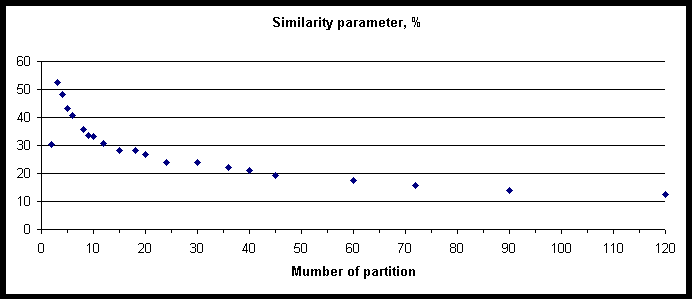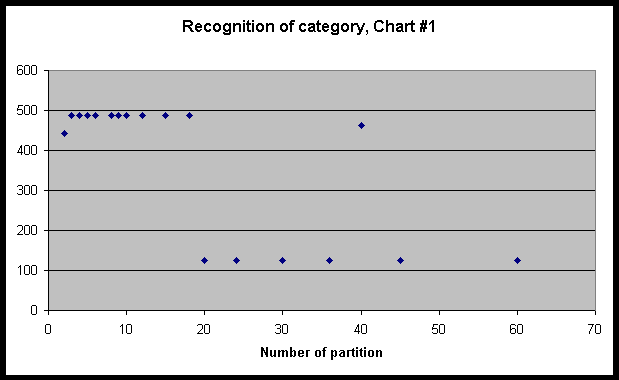
Astrology and Information Technologies
Method of birth chart recognition by using the artificial intelligence system AIDOS
As we all know, there are seven ways to decompose Zodiac circle in a process of analysing a birth chart:
Decomposition combinations such as those listed above seem to resemble algorithms of grid modelling used in modern science, in which condensation of the grid helps improve convergence in solving the task. We have used this method in order to perform packet recognition for 69 birth cards in the system of artificial intelligence (EJDOS)[1]. In order to do this a solution had to be found based on data from 19 grids of various dimensions, containing 2, 3, 4, 5, 6, 8, 9, 10, 12, 15, 18, 20, 24, 30, 36, 40, 45, 60, 72 sectors consequently. A matching parametric variable for 500 categories was found in each case, characterising professional qualities and events of life for 20007 real people, whose charts were picked and formed into a primary database [2]. Longitude of 12 cusps (Placidus house system), Moon nodes and 10 celestial bodies Sun, Moon, Mercury, Venus, Mars, Jupiter, Saturn, Uranus, Neptune, Pluto were used as input parameters for the model. By this means a simplistic version of the model [1] which used the altitude, longitude and distance to the celestial bodies were examined.
On Fig. 1 the parameter of similarity (%) of batch recognition plotted versus the logarithm (decimal) of a sector arc. It is possible to see, that in each test example data are disseminated around of average value which maximum corresponds to the arch of 120 degrees that in turn corresponds to partition of a circle of the Zodiac into three sectors. For presentation on Fig. 2 the average size of parameter of similarity depending on number of sectors of partition presented. We shall note, that an astrological decomposition signs into three groups - fixed, cardinal and mutable also is used, that corresponds to three multiply connected sectors in size of an arch in 120 degrees. As it has been established, the average parameter of similarity monotonously decreases with increase in number of sectors of splitting when it is more than them 3. Therefore in the further analysis 18 partitions of Zodiac circle up to 60 sectors were used. For each card of a birth it is possible to define the maximal size of parameter of similarity that corresponds to some category. Passing to grids of other scale of modelling, we find a number of 18 values of the maximum of similarity parameter and a number from 18 corresponding categories which numbers lay in an interval from 1 up to 500. If categories were casual the probability of occurrence of any of them in this number would make 18/500=0,036. The probability of double occurrence makes already 0,036*0,036 = 0,001296, triple - 0,000046656, quadruple - 0,000001679616, etc.
Fig. 1 Relation of similarity parameter to the sector arc for different partition of Zodiac cycle (logarithmic scale on horizontal axis).

Fig. 2. Dependence of average similarity parameter on number of sectors for different partition of Zodiac cycle.

If the category has appeared 3 and more times successively it can be considered formally as natural display of the quality inherent in the given respondent. In all studied cards triple occurrence of one category in 18 tests was revealed, and in 47 cards from 69 one category was showed 6 and more times. On Fig. 3 data of recognition of a card of the typical respondent are plotted. From these data it is possible to see, that the category "487" repeats 10 times successively, a category "127" - six times, and two categories are presented one time. It is interesting to note, that in this example repeating categories "487" and "127" duplicate each other on sense and mean "Divorce of parents". But one of them is circumstance of a life, and another event. Uniting them together, we find, that category "Divorce of parents" was identified in 16 cases from 18 tests for grids of different scale. It means, that the given card was identified with high accuracy.
In order to find all categories inherent in the given respondent, we shall act as follows. We shall set a minimum level of similarity, for example 20 %. We shall be limited to 10 grids with number of sectors of splitting 3, 4, 5, 6, 9, 12, 15, 18, 20, 24 accordingly. We shall make the table of the distinguished categories on a grid of each scale. For a card #1 it is found only 373 distinguished categories with a level of similarity, not less than 20 % among which is repeating. We shall select those from them which 4 and more times repeat. We shall make table 1 in which number of a category is specified, its description and frequency of recurrence. Among categories is such which were already realised in a personal life are categories at number 3, 5, 29, 65, 66, 159, 247, 269, 292, 423. Other categories make sense the forecast for this young man. For example, for prosperity in the USA it can be recommended him to study profession of the designer, the manager, the policeman or the photographer.
The given approach differs from a usual astrology that at recognition of images correlation functions which are calculated on each grid separately are used. These correlation functions of respondents of testing database calculated for 500 investigated categories. Thus at a stage of synthesis of model the quantity of the information which contains in the facts of hit of longitudes of corners in intervals (considered as criteria), about an accessory of the respondent to those or other categories pays off, and at a stage of identification this information is used for calculation of a degree of similarity of concrete respondents with the generalised categories. The initial purpose of research [1] was direct experimental check of the basic astrological hypothesis about dependence of features of destiny and character of the subject on position of heavenly bodies during the moment of its time of a birth in the birthplace. According to the received data, it is possible to carry out identification of the subject on its birth chart in 68 cases from 100. The method of recognition offered in the present work, allows not only to identify the subject on a number of attributes and categories, but also to predict some circumstances and events of his life.

|
Category # |
Description |
Frequency |
|
3 |
CATEGORIES: ###-Advantaged |
8 |
|
5 |
CATEGORIES: ###-Affluent family |
6 |
|
6 |
CATEGORIES: ###-Age 80 |
5 |
|
29 |
CATEGORIES: ###-Boxing |
4 |
|
40 |
CATEGORIES: ###-Coach |
4 |
|
65 |
CATEGORIES: ###-Family large |
4 |
|
66 |
CATEGORIES: ###-Family noted |
8 |
|
77 |
CATEGORIES: ###-Gracious |
4 |
|
87 |
CATEGORIES: ###-Infant mortality |
4 |
|
96 |
CATEGORIES: ###-Lottery |
5 |
|
126 |
CATEGORIES: ###-Parent absent |
10 |
|
127 |
CATEGORIES: ###-Parents divorced |
8 |
|
137 |
CATEGORIES: ###-Production jobs |
9 |
|
140 |
CATEGORIES: ###-Public relations |
6 |
|
159 |
CATEGORIES: ###-Siblings |
5 |
|
174 |
CATEGORIES: ###-Suicide Attempt |
5 |
|
184 |
CATEGORIES: ###-Verbal abuse |
4 |
|
188 |
CATEGORIES: ###-Winnings |
5 |
|
195 |
CATEGORIES: A3-Criminal Victim |
4 |
|
234 |
CATEGORIES: B2612-Missing person |
4 |
|
247 |
CATEGORIES: B36-Noted kids |
4 |
|
269 |
CATEGORIES: B803-Constitution strong |
4 |
|
283 |
CATEGORIES: C10628-Photography |
9 |
|
292 |
CATEGORIES: C12063-Unusual |
7 |
|
349 |
CATEGORIES: C19244-Designer |
9 |
|
356 |
CATEGORIES: C206-Surgery |
5 |
|
367 |
CATEGORIES: C2354-Manager |
7 |
|
407 |
CATEGORIES: C7589-Police |
10 |
|
423 |
CATEGORIES: C9318-Physical |
4 |
|
462 |
EVENT_LIFE: Family trauma |
8 |
|
480 |
EVENT_LIFE: Medical procedure |
5 |
|
482 |
EVENT_LIFE: Missing Person |
5 |
|
487 |
EVENT_LIFE: Parents divorced |
10 |
|
491 |
EVENT_LIFE: Retain professional help |
4 |
|
494 |
EVENT_LIFE: Sex Victimization/Rape |
4 |